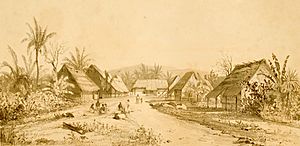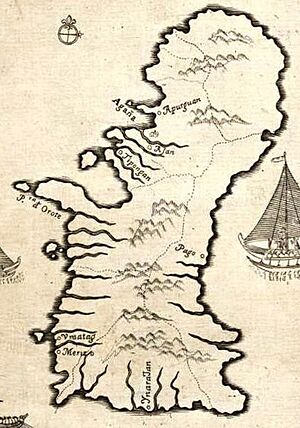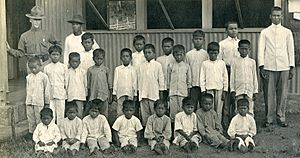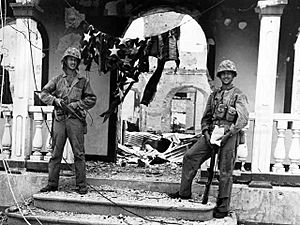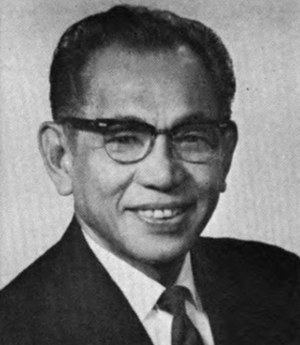History of Guam facts for kids
The history of Guam began around 2000 BC when Austronesian people first arrived. Later, in 1898, the American rule of the island started after the Spanish–American War. Guam has experienced a long history of colonialism, which means it was controlled by other countries for a very long time, longer than most other Pacific islands.
Contents
Guam Before Europeans Arrived
Early Settlers
The Mariana Islands, where Guam is located, were the first islands in a region called Remote Oceania to be settled by humans. These first settlers were Austronesian peoples who traveled across the ocean. They arrived around 1500 to 1400 BC, coming from the Philippines.
Archaeologists have found old pottery in the Mariana Islands from this time. These pots look similar to pottery found in the Northern and Central Philippines. This suggests a connection between the early people of Guam and the Philippines.
Also, the Chamoru language is very similar to languages spoken in the Philippines. This also supports the idea that the first people on Guam came from there.
Ancient Chamoru Society
Most of what we know about the ancient Chamorus comes from old stories, things found by archaeologists, and writings from early European visitors.
When Europeans first came to Guam, Chamoru society had three main groups:
- Matao: The upper class, who lived in coastal villages and had good access to fishing.
- Achaot: The middle class, who often helped the matao and mana'chang communicate.
- Mana'chang: The lower class, who lived inland.
The Chamorus also had special people like "makhanas" (shamans) and "suruhanus" (herb doctors) who were skilled in healing. Even today, some people on Guam believe in spirits of ancient Chamorros called Taotao Mona.
Early European explorers were amazed by the Chamorus' fast sailing boats, called Proas or sakman. These boats were used for trading with other islands.
Latte Stones
The latte stones are a very important part of ancient Chamoru culture. These large stone pillars have a base and a capstone, shaped from limestone. People wonder how the ancient Chamorus, without modern machines, managed to create and move these huge stones. It's believed they used sharp tools, possibly with fire, and then moved them using ropes and logs.
Latte stones were used as foundations for important buildings, like the houses of chiefs (magalahi) or perhaps even canoe sheds. Archaeologists divide Guam's history before Europeans into different periods based on these stones. The "Latte period" (from about AD 1000 to 1521) is when these large stones became common.
As the latte stones got bigger over time, it suggests that Chamoru society might have been changing, perhaps becoming more organized or having more people. This shows that ancient Chamorus lived in a lively and changing environment.
Spanish Era
Magellan's First Visit
The first time Europeans met people on Guam was on March 6, 1521. This was when a Spanish expedition, led by the explorer Ferdinand Magellan, arrived. His three ships had traveled a very long way across the Atlantic and Pacific Oceans from Spain.
Magellan's crew was tired and hungry. When they tried to get supplies, the local Chamorus, who had a different idea about owning things, came onto the ships and took items. Magellan called the islands Islas de los Ladrones ("Islands of Thieves") because of this. But he also called them Islas de las Velas Latinas ("Islands of the Lateen Sails") because of the Chamorus' incredibly fast canoes.
After some confusion, Magellan's crew was able to get fresh food and water by trading iron, which the Chamorus valued highly. This first meeting was written down by Antonio Pigafetta, one of the few crew members who survived to sail around the world.
Spanish Colonization
Even though Magellan visited, Spain didn't officially claim Guam until 1565. But it wasn't until the 17th century that Spain actually started to settle the island.
On June 15, 1668, Jesuit missionaries, led by Diego Luis de San Vitores, arrived on Guam. Their goal was to introduce Christianity and develop trade. The Spanish taught the Chamorus how to grow new crops like corn, raise cattle, and make leather. They also introduced the Spanish language and culture. The Catholic Church became a central part of village life.
Chief Quipuha was a high-ranking leader in Hagåtña when the Spanish arrived. He welcomed the missionaries and was baptized. He even gave land for the first Catholic Church in Guam, built in 1669. This helped Spain establish a base on Guam, which was important for their trade route between Mexico and the Philippines.
However, tensions grew. In April 1672, Father San Vitores and his helper, Pedro Calungsod, were killed by Chief Mata'pang. Some Chamorus thought that baptisms caused babies to die, because priests would baptize sick babies who were already close to death. This led to the Spanish-Chamorro Wars, which lasted for many years.
The Spanish fought to control the island. Villages were destroyed, and many Chamorus died from fighting, typhoons, and especially from diseases like smallpox that the Europeans brought. The Chamoru population dropped from about 50,000 to less than 5,000.
After 1695, Chamorus were asked to live in a few large villages. During this time, Spanish language and customs became common, and Catholicism became the main religion. The Spanish built roads, ports, schools, and hospitals. Many Spanish and Filipino men married Chamoru women, especially those from important families.
Later Spanish Rule
In 1767, the Spanish king ordered the Jesuits to leave all Spanish lands, including Guam. So, the Jesuit priests left Guam in 1769.
Later, Governor Don Mariano Tobias arrived in 1771. He brought many good changes, like making land available for farming, encouraging cattle raising, and setting up free public schools.
Spain built forts, like Fort Nuestra Señora de la Soledad, to protect their ships. The Spanish trade route, called the Manila Galleon trade, ended in 1815. After that, Guam became a stop for scientists, travelers, and whalers from other countries.
Guam still has many reminders of the Spanish colonial period, like old buildings and the Cathedral Dulce Nombre de Maria. The cultures of Guam and the Northern Mariana Islands gained many similarities with Spanish culture during these three centuries.
American Era
Guam Becomes American
On June 21, 1898, the United States took control of Guam without a fight during the Spanish–American War. Spain officially gave the island to the U.S. in the Treaty of Paris.
Guam became an important stop for American ships traveling to the Philippines, which the U.S. also gained from Spain. It was also a key location for the U.S. military in the Pacific. However, the U.S. Congress didn't build up Guam's defenses as much as the military wanted.
For many years, U.S. Navy officers governed Guam. The island was seen as a naval station.
World War II
During World War II, Japan attacked and invaded Guam on December 8, 1941, the same day as the attack on Pearl Harbor (due to the International Date Line). The Japanese renamed Guam Ōmiya-jima.
Chamorro people from the Northern Mariana Islands, which Japan had controlled since 1919, were brought to Guam to help the Japanese. However, the Chamorros from Guam were treated as an enemy by the Japanese military. This caused some hard feelings between the two Chamorro groups after the war.
The Japanese occupation of Guam lasted for about 31 months, from 1941 to 1944. Around 1,000 people died during this time.
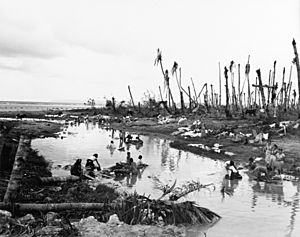
The second Battle of Guam began on July 21, 1944, when American troops landed on the island. After weeks of intense fighting, Japanese forces officially surrendered on August 10, 1944. More than 18,000 Japanese soldiers were killed.
After the war, Guam became a major base for the U.S. Navy and Air Force. New airfields, like Andersen Air Force Base, and other military facilities were built. Many of Guam's main villages, like Sumay and Hagåtña, were almost completely destroyed during the battle. Many Chamoru families had to live in temporary camps before moving to new homes.
Self-Determination
After World War II, the U.S. Navy tried to keep control of Guam's affairs. But Chamoru leaders wanted more control over their own island.
This led to the Guam Organic Act of 1950. This law created a civilian government for Guam for the first time in its history. It also made Guam an "unincorporated territory" of the United States.
In the 1960s, a special security clearance that visitors needed to come to Guam was removed. This helped the island develop its tourism industry.
In 1968, Congress passed a law allowing the people of Guam to elect their own governor and lieutenant governor. A few years later, Guam was allowed to have one delegate in the U.S. House of Representatives. This delegate can speak in debates and vote in committees, but cannot vote on the final laws on the House floor.
Guam has also tried to decide its future political status. In 1982, voters chose to have a closer relationship with the United States as a "Commonwealth." However, Guam remains an unincorporated territory today.
Modern Guam

Guam's U.S. military bases are still very important for the United States in the Pacific Ocean. When the U.S. closed its bases in the Philippines in the 1990s, many forces moved to Guam.
The lifting of the security clearance in 1963 helped Guam's tourism industry grow quickly. The island's economy also grew with more U.S. government spending.
Guam has also faced challenges. In 1997, a plane crash killed many people. The 1997 Asian financial crisis and powerful typhoons like Typhoon Paka (1997) and Typhoon Pongsona (2002) hurt Guam's tourism. However, the tourism industry has recovered, and U.S. military spending has increased.
In recent years, there have been plans to move more U.S. Marines to Guam from Okinawa. A new base, Marine Corps Base Camp Blaz, was opened in 2020.
In 2017, North Korea warned it might launch missiles near Guam, which caused some concern.
A report in 2018 mentioned that a chemical called Agent Orange was used as a weed killer on Guam during the Vietnam and Korean Wars. This has raised health concerns for some veterans who were exposed to these chemicals.
Today, Guam is a diverse place. Many Chamorus are working to preserve their culture and identity, especially as more young Chamorus move to the U.S. mainland.
See also
 In Spanish: Historia de Guam para niños
In Spanish: Historia de Guam para niños
- Guam
- Villages of Guam
- San Vitores
- Chief Kepuha





